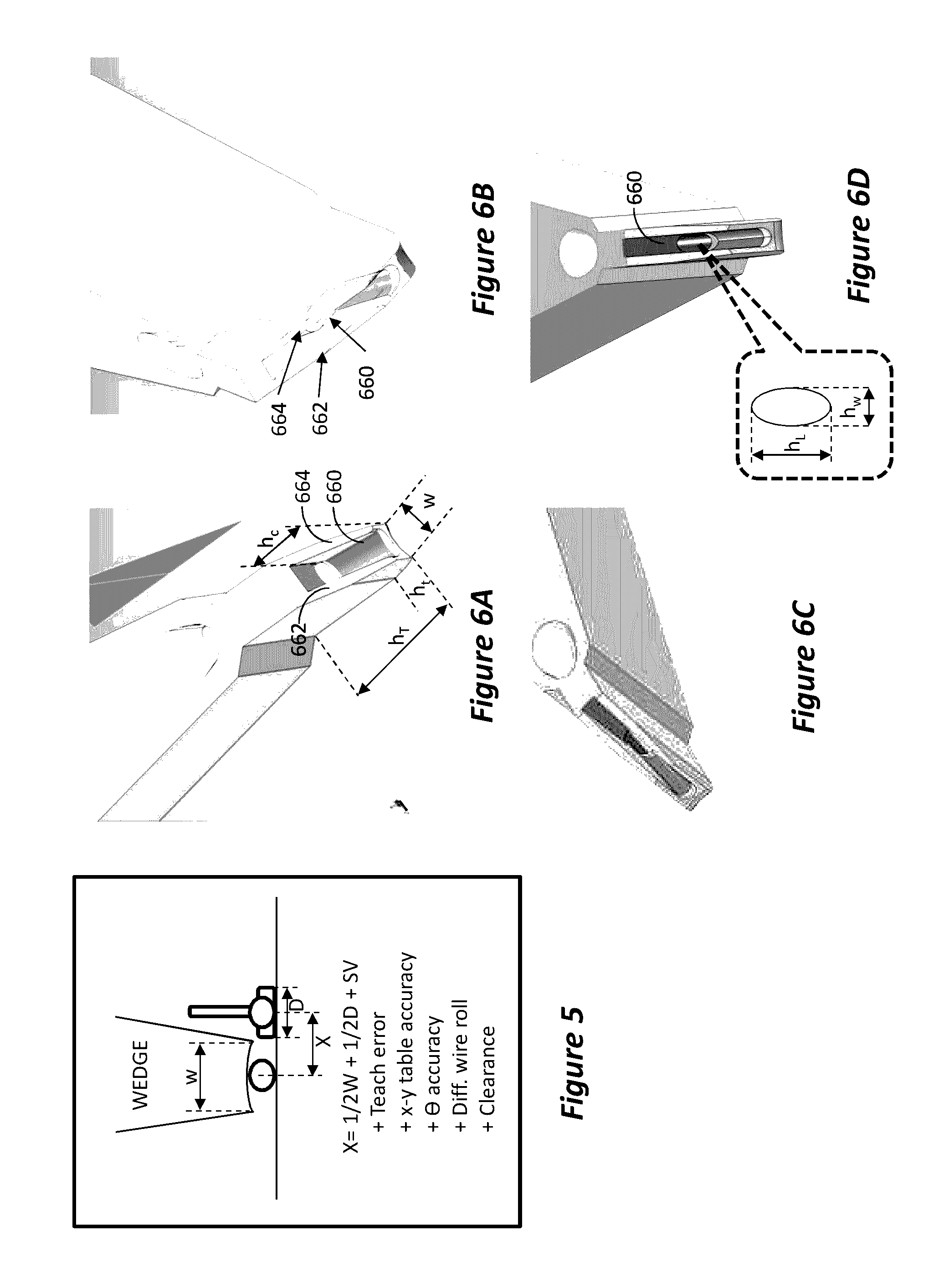Ultra fine pitch wedge for thicker wire
a wire thickness and ultra-fine technology, applied in the direction of manufacturing tools, basic electric elements, electric devices, etc., can solve the problems of affecting the performance and reliability of the device, the deformation caused by ball bonding requires a much larger pitch, and the limit of ball bonding
- Summary
- Abstract
- Description
- Claims
- Application Information
AI Technical Summary
Benefits of technology
Problems solved by technology
Method used
Image
Examples
example i
[0037]A wedge tool was designed for ultra-fine wire pitch of 35 microns. With reference to FIG. 5, the following calculations are done in order to create a theoretical design, based on the application data. FIG. 5 illustrates the factors to be considered for final wedge width, W.
Variables:
[0038]WD(WireDiameter)=20μmd(bonddeformation)=22%SV(SquashVariation)=1μmD(SquashWidth)=WD×(100+d)100D(SquashWidth)=20×(100+22)100D(SquashWidth)=24.4μm_
Source of Error:
[0039]T(TeachError)=1μmTa(X-YTableAccuracy)=0.5μmΘ(ThetaAccuracy)=0μmWr(WireRollunderthewedge)=0μmC(Clearance)=0μmX(Pad,WirePitch)=35μmX=(W+D)2+Sv+T+Ta+θ+Wr+C(W+D)2=X-(Sv+T+Ta+θ+Wr+C)W(WedgeWidth)=2×[X-(Sv+T+Ta+θ+Wr+C)]-DW(WedgeWidth)=2×[35-(1+1+0.5+0+0+0)]-24.4W(WedgeWidth)=40.6μm(1.6mil)_
[0040]Therefore, according to this example, the new 35 μm wedge tool includes the following features. The wedge has narrow front wedge width of 1.6 mil (40.6 μm) to keep th...
example ii
[0051]FIGS. 6A-6D illustrate various views of the tip of a wedge tool designed according to the above parameters and suitable for ultra-fine wire pitch, such as 35 microns. FIGS. 7A-7C are illustration of front (leading) edge, side, and rear (wire-feeding edge) views, respectively, of the designed wedge tool according to this example. The design of this example is configured to conform to two opposing requirements, namely, be very thin so as to enable placing between wires bonded at ultra-fine pitch and at the same time have wide hole enabling the threading of a large diameter wire—without the hole weakening the tip of the wedge tool. As illustrated in FIGS. 7A-7C, much of the upper part of the wedge tool is an elongated block the design of which is not relevant to the design or operation of the tool, it is therefore illustrated as truncated and is referred to herein as main body. The lower part of the wedge tool undergoes tapering by several tapered sections, culminating in a foot ...
example iii
[0059]A method for fabricating an ultra-fine pitch wedge tool has been developed. The method starts by obtaining a substantially rectangular slab of a tungsten carbide alloy having grain size of 0.5 μm or smaller, density above 14.5 g / cm3, hardness higher than 90 HRa or 2,000 HV30, and transverse rupture strength higher than 400 KPSI. The slab is machined to form a main body part, a tapered part reducing the width of the main body part towards a tip part, and a tip part extending from the tapered part and terminating at the bottom of the tool to form a bonding foot. The tip part is further machined to have a tip tapered part, so as to reduce the width of the tip such that the foot has the smallest width, Wt, of the wedge tool. The width Wt is calculated to enable bonding wires at ultra-fine pitch, i.e., pitch of 35 μm or less.
[0060]In order to enable the use of a thick wire, a pocket 660 is formed at the bottom of the tip, behind the bonding foot. The pocket extends from the bottom ...
PUM
| Property | Measurement | Unit |
|---|---|---|
| acute angle | aaaaa | aaaaa |
| grain size | aaaaa | aaaaa |
| density | aaaaa | aaaaa |
Abstract
Description
Claims
Application Information
 Login to View More
Login to View More - R&D
- Intellectual Property
- Life Sciences
- Materials
- Tech Scout
- Unparalleled Data Quality
- Higher Quality Content
- 60% Fewer Hallucinations
Browse by: Latest US Patents, China's latest patents, Technical Efficacy Thesaurus, Application Domain, Technology Topic, Popular Technical Reports.
© 2025 PatSnap. All rights reserved.Legal|Privacy policy|Modern Slavery Act Transparency Statement|Sitemap|About US| Contact US: help@patsnap.com



